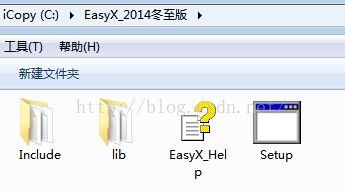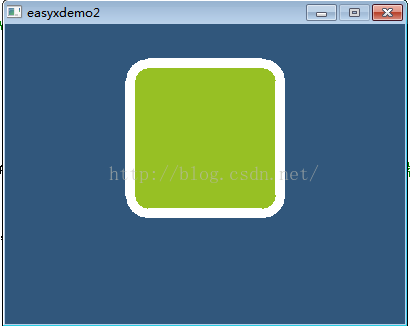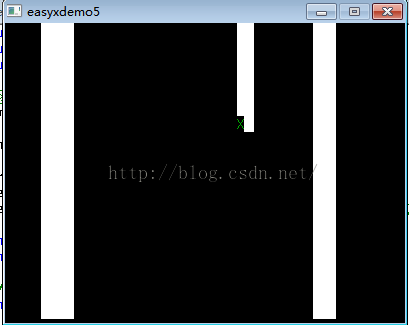图解在VC里使用graphics.h绘图(类似TC)
1 www.easyx.cn 下载 EasyX 库
我下的2014;解压后如下图;
2 根据自己的VC 版本进行安装
3 在控制台画一个圆
#include <graphics.h> // 引用图形库
#include <conio.h>
void main()
{
initgraph(640, 480); // 初始化绘图窗口
circle(200, 200, 100); // 画圆,圆心(200, 200),半径 100
getch(); // 按任意键继续
closegraph(); // 关闭图形界面
}
4 在控制台画一个方块
#include <graphics.h>
#include <conio.h>
#define PI 3.14159265
void main()
{
// 创建大小为 800 * 600 的绘图窗口
initgraph(400, 300);
// 设置原点 (0, 0) 为屏幕中央(Y轴默认向下为正)
setorigin(200, 150);
// 使用藏青色填充背景
setbkcolor(0x7c5731);
cleardevice();
// 设置绘图样式
setlinecolor(WHITE); // 设置线条颜色为白色
setlinestyle(PS_SOLID | PS_ENDCAP_FLAT, 10); // 设置线条样式为宽度 10 的实线,端点是平的
setfillcolor(0x24c097); // 设置填充颜色为绿色
// 画方块
fillroundrect(-75, -111, 75, 39, 36, 36);
// 按任意键退出
_getch();
closegraph();
}
5 星空
这是来自easyx网站上的一个范例;
// 程序名称:星空
// 编译环境:Visual C++ 6.0,EasyX 2011惊蛰版
// 最后更新:2009-2-22
//
#include <graphics.h>
#include <time.h>
#include <conio.h>
#define MAXSTAR 200 // 星星总数
struct STAR
{
double x;
int y;
double step;
int color;
};
STAR star[MAXSTAR];
// 初始化星星
void InitStar(int i)
{
star[i].x = 0;
star[i].y = rand() % 480;
star[i].step = (rand() % 5000) / 1000.0 + 1;
star[i].color = (int)(star[i].step * 255 / 6.0 + 0.5); // 速度越快,颜色越亮
star[i].color = RGB(star[i].color, star[i].color, star[i].color);
}
// 移动星星
void MoveStar(int i)
{
// 擦掉原来的星星
putpixel((int)star[i].x, star[i].y, 0);
// 计算新位置
star[i].x += star[i].step;
if (star[i].x > 640) InitStar(i);
// 画新星星
putpixel((int)star[i].x, star[i].y, star[i].color);
}
// 主函数
void main()
{
srand((unsigned)time(NULL)); // 随机种子
initgraph(640, 480); // 打开图形窗口
// 初始化所有星星
for(int i=0; i<MAXSTAR; i++)
{
InitStar(i);
star[i].x = rand() % 640;
}
// 绘制星空,按任意键退出
while(!kbhit())
{
for(int i=0; i<MAXSTAR; i++)
MoveStar(i);
Sleep(20);
}
closegraph(); // 关闭图形窗口
}
6 屏幕截图
这也是来自easyx网站的例子,演示了graphics.h也可在Win32程序中使用;
/////////////////////////////////////////////////////////
// 程序名称:实现桌面截图
// 编译环境:Visual C++ 6.0 / 2010,EasyX 20130117(beta)
// 作 者:yangw80 <yw80@qq.com>
// 最后修改:2013-1-29
// 项目类型:Win32 Application
//
#include <graphics.h>
// 抓取桌面图像到 *pimg 对象中
void CaptureDesktop(IMAGE *pimg)
{
// 通过 Windows API 获取桌面的宽高
int w = GetSystemMetrics(SM_CXSCREEN) / 2;
int h = GetSystemMetrics(SM_CYSCREEN) / 2;
// 调整 pimg 的大小
Resize(pimg, w, h);
// 获取桌面 DC
HDC srcDC = GetDC(NULL);
// 获取 IMAGE 对象的 DC
HDC dstDC = GetImageHDC(pimg);
// 在两个 DC 之间执行图像拷贝,将桌面抓图拷贝到 IMAGE 对象里面
BitBlt(dstDC, 0, 0, w, h, srcDC, 0, 0, SRCCOPY);
}
// 主函数
int APIENTRY WinMain(HINSTANCE hInstance, HINSTANCE hPrevInstance, LPSTR lpCmdLine, int nCmdShow)
{
// 定义 IMAGE 对象
IMAGE img;
// 调用抓取桌面图像的函数
CaptureDesktop(&img);
// 创建绘图窗口
initgraph(500, 300);
// 在窗口中显示 IMAGE 中保存的桌面图像
putimage(0, 0, &img);
// 按 ESC 键退出
while(!(GetAsyncKeyState(VK_ESCAPE) & 0x8000))
Sleep(20);
closegraph();
return 0;
}
7 做一个字符动画
做一个字符从控制台窗口顶端往下落的动画;
#include <graphics.h>
#include <conio.h>
#include <time.h>
// 主函数
void main()
{
initgraph(400, 300); // 初始化屏幕为 640x480
srand(time(NULL)); // 设置随机种子
setfont(16, 0, "Arial"); // 设置字母的字体和大小
setfillstyle(BLACK); // 设置清除字母的填充区域颜色
char target; // 目标字母
int x, y; // 字母的位置
// 主循环
while(true)
{
target = 65 + rand() % 26; // 产生任意大写字母
x = rand() % 380; // 产生任意下落位置
for (y=0; y<280; y++)
{
setcolor(GREEN); // 设置字母的颜色
outtextxy(x, y, target); // 显示字母
// 延时,并清除字母
Sleep(10);
bar(x, y, x + 16, y + 16);
}
}
// 关闭图形界面
closegraph();
}
还有些问题,下落的字母会拖着一个白色尾巴;下次再搞;
8 改进
在 VC 中创建代码请直接使用默认的 .cpp 扩展名,不要加 .c 扩展名。
并不是所有的 TC 绘图函数都能支持,许多函数在 EasyX 库中都变得更强大了,比如颜色,过去 TC 只能支持 16 色,现在可以支持上千万种颜色。还有字体,可以使用 Windows 下安装的任何字体,等等。参考帮助。
上述工程下载
http://pan.baidu.com/s/1o8qyWLs
文件名
easyxdemo




